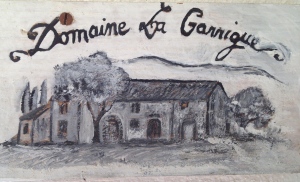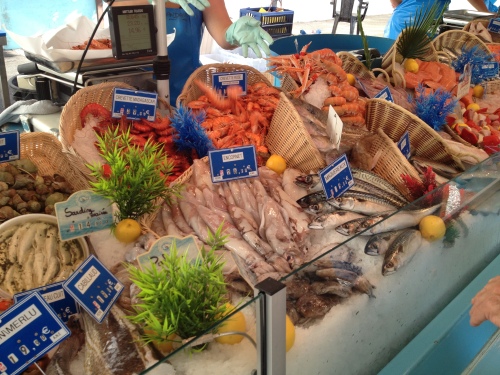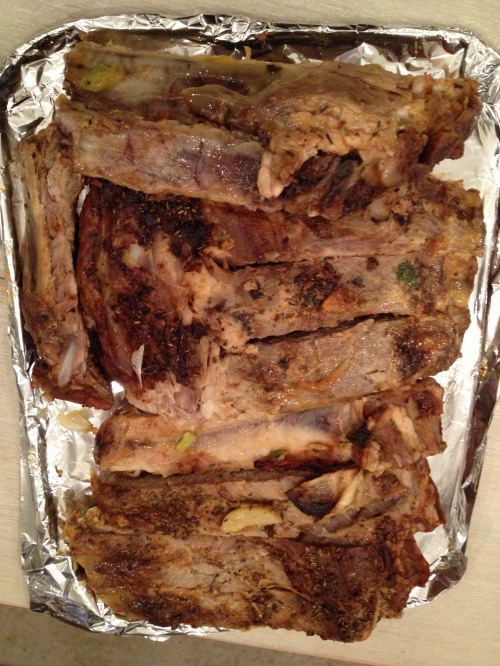’’This year, we spent our vacation in Provence. We rented a house in the tiny town of St. Romaine en Viennois, just a half hour or less from the villages of Gigondas, Beaumes-De Venise, and Chateauneuf du Pape. The house overlooks a valley of vines and every morning I enjoyed walking among the vines and watching the farmers at work. We spent 10 days there and drank a lot of rosé, some whites, and a few reds.
Then we went to a friend’s home in Eze Village for two days. Here we drank mostly red wine.
Red Beaumes-De-Venise “Les Trois Amours” 2008 Domaine Beauvalcinte, made from 50% Grenache, 20% Mourvedre, 10% Syrah, 10% Carignan, 5% Counoise and 5% Cinsault. The grapes are destemmed and fermentation takes place in concrete tanks with natural yeast under controlled temperatures. Maceration lasts for 24 days. This was a very nice wine with red fruit flavors and aromas with hints of raspberry.
The soil in Gigondas is composed of limestone, clay and small stones which seemed to be everywhere. The vineyards are on the hills and the plateau and can be seen from the village above.
Gigondas 2001 Domaine De La Jaufrette. The wine is made from 90% Grenache and 10% Syrah. It stays 2 to 3 years in vats and 6 to18 months in foudres according to the vintage and 6 to 8 months in bottle before release. The wine was showing very well with dark fruit aromas and flavors and a hint of spice and leather. There was some wine left in the bottle and I had it with lunch the next day. It tasted even better.
The territory of Chateauneuf-du-Pape is north of Avignon on the left bank of the Rhone. It covers the five communes between Orange and Avignon. Clay and limestone “galettes,” large round stones, help the vines to withstand the dry Mediterranean climate and the mistral (strong winds).
Chateauneuf-du-Pape Blanc 2009 Domaine du Grand Tinel. The wine is made from 60% Grenache Blanc, 20% Clairette and 20% Bourboulance. 90% of the wine is aged in stainless steel tanks and the rest in new oak barrels. The wine was dry with a mineral character and hints of grapefruit. It worked very well with tapenade, olives and thumb size sausages that we had as an appetizer.
Chateauneuf-du-Pape Blanc 2000 Chateau La Nerthe made from 39% Roussanne, 27% Grenache Blanc,19% Clairette and 15% Bourboulence. I do not think the wines undergo malolatic fermentation and 38% of the wine is aged in wood and 62% in tanks. The wood might be barriques. This was the oldest blanc from here that I have had. The wine was showing its age with ripe fruit and a mineral character but it went very well with the smoked salmon we had with lunch.
Chateauneuf-du-Pape 1989 Chateau Cabrieres made from 50% Grenache, 20% Syrah 20% Mourvedre and 10 Cinsault. The harvest is by hand and usually takes place in the middle of September. There is a select sorting of the grapes. Fermentation lasts for 4 weeks and includes pumping over, delestage and later malolatic fermentation. The wines are assembled and undergo a light filtration and are aged in Allier oak for 6-12 months. It was drinking like a good older wine with hints of black fruit, prune and spice. It had a nice finish and aftertaste.
The wines of Cassis
The fishing village and seashore resort of Cassis is situated in the western part of the Cote d’Azur not far from Marseille. The appelation is restricted to the commune of Cassis which covers only some 80 hectares. Here they produce white, rosé and red wine. They are known first for their whites, somewhat for their rosé, and least of all for their reds. At the house of a friend in Eze Village I was able to taste all three.
Blanc de Blancs Cassis 2009 Domaine du Paternal made from Ugni Blanc, Clairette, Marsanne and Doucillon. I was very impressed with this wine. It was balanced, with good acidity, aromas and flavors of grapefruit, herbs, a touch of spice, good mineral character and a very nice finish and aftertaste. It was a delight to drink on the terrace looking at the village of Eze.
Rosé Cassis 2009 Domaine Du Bagnol made from Grenache, Mourvedre, Cinsault, and Carignan. This is a fruity wine with a dry, full body with hints a strawberry and raspberry.
Red Cassis 2008 Domaine du Paternal made from the same grapes as the Rosé. I had never had a red wine from Cassis before. The red was interesting but not as good as the white.
Cornas, scorched earth. The production zone has a south/southwest exposure with a semicircle of hill which protect it from the winds and steep terraced hills. The soil contains granite. It has a hot and dry Mediterranean climate. Because of these factors, the grapes are the first to be harvested in the Northern Rhone. The area covers 115 hectares all planted with Syrah.
Cornas Terre Brulee 2004 100% Syrah Domaine Lionnet, they only use organic farming methods and all of the work is done by hand. The only have 2.2 hectares and the vines are between 40-100 years old. All the farming is done by the lunar calendar when possible. The land is worked by a tractor or a horse. No additives are used in making the wine. Only natural yeast is used to have a real expression of the terroir. Grape bunches are placed in small open tanks and the maceration lasts for three weeks. The grapes are “walked on” several times a day during this time. The pulp and stems are shoveled by hand into a 19 century vertical press where a slow pressing takes place. The wine is temporarily placed in tanks so that malolatic fermentation can take place. After the wine is racked and separated from the lees it remains in barrels for two winters. There is no filtration and no new oak is used. I was very impressed with this wine. It was a big wine with cooked black fruit aromas and flavors, hints of cassis, spice, licorice and a touch of violets.

The Wines in the House in Eze

The Wines in the House in St. Romaine en Viennois












































































